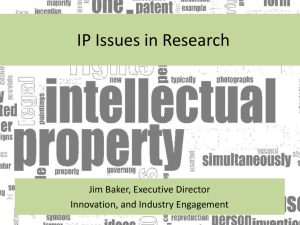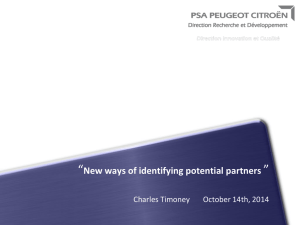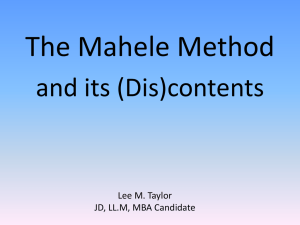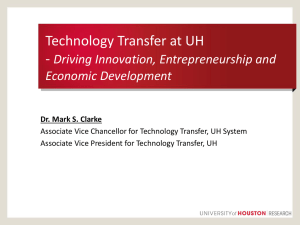David Blackwell - What is your IP worth
advertisement
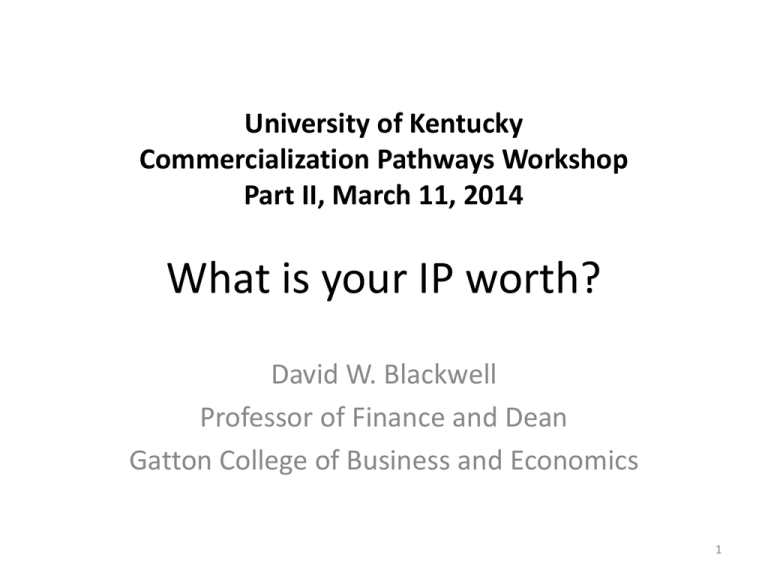
University of Kentucky Commercialization Pathways Workshop Part II, March 11, 2014 What is your IP worth? David W. Blackwell Professor of Finance and Dean Gatton College of Business and Economics 1 Commercialization Pathways • Sponsored Research • License to Industry • Startup Company • How do you decide? • What’s best for the inventor? • What’s best for UK? Source: Von Allmen Center for Entrepreneurship 2 Commercialization Pathways 1 2 3 4 Sponsored research License to industry License to product startup License to development startup 1 Industry Partner UK 2 Startup M A R K E T 4 3 Source: Von Allmen Center for Entrepreneurship 3 Commercialization Pathways 1 2 3 4 1 UK 2 patent expenses progress payments royalties equity Sponsored research License to industry License to product startup License to development startup 1st lab funding rights to license M A R K E T Industry Partner patent expenses progress payments royalties progress payments royalties Startup 4 3 Source: Von Allmen Center for Entrepreneurship product/service sales 4 Client Stories (UK) UK Royalty Distribution UK patent expenses royalties equity progress payments licensee after repayment of patent expenses • 40% inventors • 20% inventors’ department(s) • 20% inventors’ college(s) • 20% UKRF Source: Von Allmen Center for Entrepreneurship 5 Client Stories (UK) UK Royalty Distribution Simplified Example after payment of patent expenses $5 patent expenses royalties equity progress payments UK $5 $2 $1 $1 $1 $100 sales 5% royalty licensee after repayment of patent expenses • 40% inventors • 20% inventors’ department(s) • 20% inventors’ college(s) • 20% UKRF Source: Von Allmen Center for Entrepreneurship 6 1 Client Stories (UK) Sponsored Research Benefits • Provides funding for UK research • Creates early industry partnership Challenges • In many cases, hard to find company willing to do • Potential conflicts on IP ownership • Company usually has first rights to license, potentially limiting commercialization options Example where it is the preferred approach Energy opportunity where… • industry partner does not have internal research expertise • commercialization can only be done by industry • funding required is very large and time to market is long • heavy regulatory requirements 7 2 Client to Stories (UK) License Industry Benefits Challenges • Creates ongoing royalties for life of patent • Many companies want further along in development before licensing • Minimizes UK & inventor resources in commercialization process • Need to monitor licensee keeps focus on commercialization • Doesn’t contribute to local/state economic development Example where it is the preferred approach Agriculture opportunity where… • UK IP has large market opportunity and first office action is positive • commercialization can only be done by industry • funding required is very large and time to market is long • regulatory requirements Source: Von Allmen Center for Entrepreneurship 8 3 Client Stories Startup (UK) License to Product Benefits • Offers inventor opportunity to participate in bringing product to market, and to own equity • Startup controls priorities Challenges • Inventor must carefully manage potential conflict of interest with UK responsibilities • Finding the right management team is hard • Raising money is a continual challenge • Contributes to job creation and economic development in Kentucky Example where it is the preferred approach Engineering opportunity where… • UK IP has large market opportunity • SBIR/STTRs and angel funding can bring to market or to next funding stage • Time to market is relatively short • Strong management team is available with both technical and business experience • No regulatory requirements 9 Source: Von Allmen Center for Entrepreneurship 4 Stories (UK) License Client to Development Startup Benefits • Offers inventor opportunity to participate in bringing product to market, and to own equity • Increases license value by being further along in commercialization stage Challenges • Inventor must carefully manage potential conflict of interest with UK responsibilities • Finding the right management team is hard • Raising money is a continual challenge • Contributes to job creation and economic development in Kentucky Example where it is the preferred approach Medical device opportunity where… • UK IP has large market opportunity • SBIR/STTRs and angel funding can bring to prototype and hopefully early clinical results • Time to license to industry player is a few years, and target licensee(s) have been identified • Strong management team is available with both technical and business experience • Minimal/moderate regulatory requirements 10 Client Stories (UK) Startup Distribution Simplified Example $5 patent expenses royalties equity progress payments UK $100 sales Startup equity ? share of profits $5 $2 $1 $1 $1 after repayment of patent expenses • 40% inventors • 20% inventors’ department(s) • 20% inventors’ college(s) • 20% UKRF Source: Von Allmen Center for Entrepreneurship 11 Commercialization Pathways Guidelines Startup License Time to market < 3 years >7 years Funding required <$10 million >$50 million Regulatory requirements Low High Proposed product Complete solution Add-on to market leader Inventor involvement High Low never this clear cut, right solution depends on individual circumstances Source: Von Allmen Center for Entrepreneurship 12 $1 billion in sales since the late 1980s! 13 Source: http://spectrum.ieee.org/semiconductors/devices/super-soaker-inventorinvents-new-thermoelectric-generator Lonnie Johnson “Rocket Scientist” (Former nuclear engineer for the Strategic Air Command) 14 Super Soaker Inventor Invents New Thermoelectric Generator Lonnie Johnson has moved on from highpowered squirt guns to a chip that converts heat from the sun--or anything else--into electricity Among the potential applications are at utilityscale solar thermal farms and for plug-in hybrid vehicles, in which the device would use waste heat from the car’s internal combustion engine to help power the car’s electric motor. Johnson even envisions a day when miniaturized versions will power consumer electronics. Imagine your laptop producing power from its own waste heat, your cellphone being charged as you hold the handset against your face, or an implantable medical device exploiting the difference in temperature between, say, your chest cavity and the skin on your arm. Source: http://spectrum.ieee.org/semiconductors/devices/super-soaker-inventor15 invents-new-thermoelectric-generator Is it in your personality to do a start-up? • “Unstoppable skill at selling!” – Ron Popeil: Veg-o-Matic; Pocket Fisherman • Are you a business innovator? – Lonnie Johnson: Super Soaker; thin battery technology (Excellatron); miniature “heat pump;” process that converts thermal energy to electrical energy using a nonsteam process which works by pushing hydrogen ions through two membranes, with significant advantages over alternative systems • Are you a talented manager? • Are you a risk taker? • Do you have access to capital? Source: Forbes, Should You License or Produce Your Invention?, 10-24-2006 16 Source: Gene Quinn, http://www.ipwatchdog.com/2011/05/20/to-license-or-tomanufacture-that-is-the-question/id=17036/ 17 Determination of Royalty Rates • Profitability of the IP and how the profit is shared between licensor and licensee (income approach) – 25% of profits rule (heuristic starting point) – Impact of uncertainty – IP typically used with other assets; thus, how to apportion? • Market based approach (comparables) – Royalty rates in arm’s length transactions on similar IP – Difficult to find “comps” • Structure of the license agreement – Duration – Exclusivity – Lump sum payments Source: Tim Heberden, Intellectual Property Valuation and Royalty Determination, Chapter 4 of International Licensing and Technology Transfer: Practice and the Law 18 Source: Profitability and royalty rates across industries: Some preliminary evidence, KPMG International, Global Valuation Institute, 2012 19 Source: Profitability and royalty rates across industries: Some preliminary evidence, KPMG International, Global Valuation Institute, 2012 20 How valuable is the IP? • How important is the invention? – Transformative—gene splicing? – Incremental—adding squeaky noise to a toy? – Citations to your patent? • Is the patent well constructed? – Does the patent protect the IP? • Market dynamics and licensing strategy – Competition – Structure of deals? 21 What determines the profitability of the IP? • • • • • • • Uniqueness Know-how Design-around Number of suitable licenses Risks of two parties Level of investment by each party Incremental profitability relative to industry norms 22 Example Profit Split Source: Tim Heberden, Intellectual Property Valuation and Royalty Determination, Chapter 4 of International Licensing and Technology Transfer: Practice and the Law 23 Source: Tim Heberden, Intellectual Property Valuation and Royalty Determination, Chapter 4 of International Licensing and Technology Transfer: Practice and the Law 24 ktMine Royalty Rate Resource Guide 2013 25 ktMine Royalty Rate Resource Guide 2013 26 ktMine Royalty Rate Resource Guide 2013 27 ktMine Royalty Rate Resource Guide 2013 28 ktMine Royalty Rate Resource Guide 2013 29 ktMine Royalty Rate Resource Guide 2013 30 ktMine Royalty Rate Resource Guide 2013 31 ktMine Royalty Rate Resource Guide 2013 32 Legal Requirements for Patent Validity that Relate to the Economic Value of IP • Utility • Novelty • Nonobviousness 33 Selected Georgia-Pacific Factors •The rates paid by the licensee for the use of other patents comparable to the patent-in-suit; •The nature and scope of the license, as exclusive or non-exclusive, or as restricted or non-restricted in terms of territory or with respect to whom the manufactured product may be sold; •The licensor’s established policy and marketing program to maintain its patent monopoly by not licensing others to use the invention or by granting licenses under special conditions designed to preserve that monopoly; •The commercial relationship between the licensor and the licensee, such as whether they are competitors in the same territory in the same line of business, or whether they are inventor and promoter; •The effect of selling the patented specialty in promoting sales of other products of the licensee; the existing value of the invention to the licensor as a generator of sales of its non-patented items; and the extent of such derivative or convoyed sales; •The duration of the patent and the term of the license; •The established profitability of the product made under the patent; its commercial success; and its current popularity; •The utility and advantages of the patent property over the old modes or devices, if any, that had been used for working out similar results; •The nature of the patented invention; the character of the commercial embodiment of it as owned and produced by the licensor; and the benefits to those who have used the invention; •The portion of the profit or of the selling price that may be customary in the particular business or in comparable businesses to allow for the use of the invention or analogous inventions; •The portion of the realizable profit that should be credited to the invention as distinguished from nonpatented elements, the manufacturing process, business risks, or significant features or improvements added by the infringer; 34
